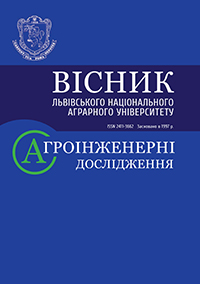ANALYSIS OF STEADY-STATE HARMONIC ELECTRIC SKIN-EFFECT IN THE BYPASS OF THE CURVES OF EMDE
DOI:
https://doi.org/10.31734/agroengineering2018.01.148Keywords:
short-circuit asynchronous motor, electric skin effect, transient and steady-state processes, deep rectangular slot, analytical solutionAbstract
Execution deep bar cage induction motors play an important role in the national economy, both in industry and in the agro-industrial complex. The intense electric skin effect that occurs in such slots performs direct work functions. Therefore, the reproduction of the corresponding electromagnetic phenomenon in the process of mathematical modeling should be performed with a sufficient accuracy for practice. Since in this case the current is distributed unevenly across the conductor, then such a concept of the theory of electric tracks as the ohmic resistance of the conductor loses its physical meaning. Appropriate solutions can be obtained only on the basis of the theory of a quasistationary electromagnetic field. On this basis, we solved the problem in its general form. The resulting solutions are suitable for analysis of both transient and steady-state processes. Obtained with this boundary-value problem is suitable for analysis as of transient skin effect in the general case, and in the case of a deep rectangular slot of an electric machine is solved by numerical methods [18; 19].
As is shown by F. Emde, there is an analytical solution in the jumble of a jumbled sinusoidal current of a rectangular deep slot that lies in ferromagnetics. He proceeded from the power of the electromagnetic field. But the solution thus has the complex appearance that it was possible to offer it to the user only in a graphical form known as the "curves of Emde." At that time, the solution we have proposed, obtained by the value of the electric field strength vector on the surface of the conductor, is expressed by a simple hyperbolic function of a complex variable.
If the complex resistance of the conductor obtained by us, which includes both the ohmic and internal inductive supports, is decomposed into real and imaginary parts, then we can come to the result obtained by Emde.
References
Czaban A., Czaban W., Rusek A., Lis M. Model matematyczny silnika synchronicznego z magnesami trwalymi typu PMSM z wykorzystaniem metod wariacyjnych. Maszyny Elektryczne, Zeszyty Problemowe. 2013. Nr. 1 (98). S. 177–182.
Emde F. Einseitige Stromferdrаgung in ankernuten. E. u. M. 1908. Bd. 20, H. 33. S. 703–718; H. 34. S. 726–731.
Klingshirn E. A., Jordan H. E. Simulation of polyphase induction mashines with deep rotor bare. IEEE Trans Power App. And Syst. 1970. PAS 80, N 6.
P. 58–67.
Mocanu C. I. Nichtstationare Stromverdrangung in einer maschinennut von rechtekigen Querschnit. A. f. E. 1973. Bd. 55, H. 3. P. 164–170.
Padarew N., Jetschew D. Die Beistimung der dynamischen Kennlinien von Asynchronmotoren unter Berucksichtigung der Sattigung und der Stromverdrangung mit Digitalrechnern. Electrie. 1971.
N 9. S. 132–141.
Probst R. Ubergangsverdrangung von Asynchronmotoren mit Nutzumschaltung unter Berucksichtikung der Stromverdrangung in den Lapferstaben. ETZ-A. 1973. H-9. Bd. 94. S. 88–96.
Reichert K. Die numerische Berechnung Nutzst Steiung und der Wirbelstrome in Nutenleitern electrischer Maschinen. A. f. E. 1969. Bd. 53. H-2.
S. 131–139.
Stepina J. Querstrome in Kefiglaufer. E. u. M. 1975. Vol. 92, N 1. P. 8–14.
Tchaban V. New principle of building of mathematical models of electric devices. International conference on modellinq and simulation MS'2001.: Proceedings, Lviv, May 23-26, 2001. Lviv, 2001.
P. 17–18.
Tchaban V. Parametrc sensitivity of three-phase induction motor. Technical News. 2014. 1(39), 2(40).
P. 26–29.
Tchaban V., Kostiuchko S., Kwater T. Mathematical modeling of nonsymetrical transient and steady-state processes of induction motors. Computing in Sciense and Technology: monograph. Rzeszow: Agencja Rekl.-Wydawn. A. Grzegorczyk, 2012. P. 129–146.
Tchaban V., Labyak N. Mathematical modelling of transient processes of induction motors with massive rotor. Modelling, Measurement and Control. 1993.
Vol. 51, No. 4. S. 37–41.
Tchaban V., Peleshko D. The mathematical model of invertor. Przeglad elektrotechniczny. 2012. Nr. 6. R. 88. S. 251-253.
Tchaban V., Bobytsky Y., Ivinski D. Mathematical model of elementary DC photomotor. Proceedings of 2-nd International conference on intelligent knowledge systems (IKS-2005), July 06-08, 2005. TR-Kütahya, Turkey, 2005. P. 65–67.
Dachev A. Izsledovanie na pov'erhnostii efekt v provodnitsi i otvoreni feromagnetni kanali s pomoschta na zamestashi shemi i elektronii tsifrovi izchisl. Mashini (ETsIM). Tehn. misli. 1971. 8, № 6. C. 78–83.
Chaban V. Algoritm rascheta skin-effekta v pazah elektricheskih mashin. Elektronnoe modelirovanie. 1990. № 3. S. 103–105.
Chaban V. Elektromagnetni protsesy. Lviv: Prostir M, 2017. 412 s.
Chaban V. Metody neliniinoi elektrotekhniky. Lviv: Svit, 1990. 168 s.
Chaban V., Chaban A., Bondar O. Komutatsiinyi rezhym strumoprovodu. Tekhnichni visti. 2000. № 1 (10)/2 (11). S. 69–71.
Shimoni K. Teoreticheskaya elektrotehnika (per. s nem.). Moskva: Mir, 1964. 774 s.


